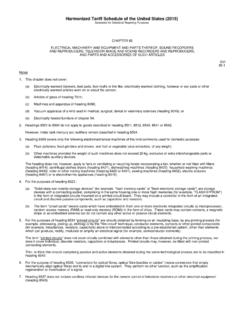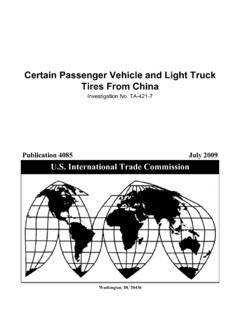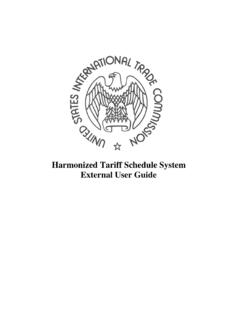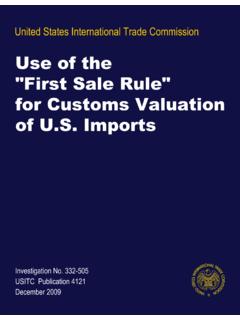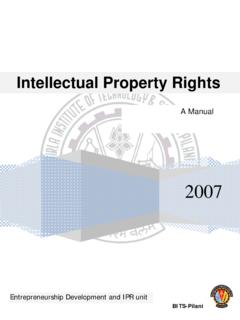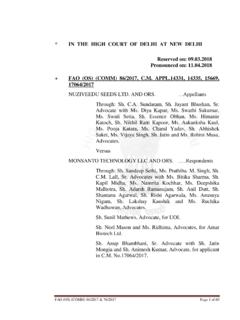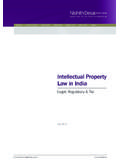Transcription of The Emergence of India’s Pharmaceutical Industry …
1 No. 2007-05-A. OFFICE OF ECONOMICS WORKING PAPER. INTERNATIONAL TRADE COMMISSION. The Emergence of india 's Pharmaceutical Industry and Implications for the Generic Drug Market William Greene International Trade Commission May 2007. The author is with the Office of Economics of the International Trade Commission. Office of Economics working papers are the result of the ongoing professional research of USITC Staff and are solely meant to represent the opinions and professional research of individual authors. These papers are not meant to represent in any way the views of the International Trade Commission or any of its individual Commissioners. Working papers are circulated to promote the active exchange of ideas between USITC Staff and recognized experts outside the USITC, and to promote professional development of Office staff by encouraging outside professional critique of staff research. Address correspondence to: Office of Economics International Trade Commission Washington, DC 20436 USA.
2 The Emergence of india 's Pharmaceutical Industry and Implications for the Generic Drug Market William Greene International Trade Commission ABSTRACT: This paper presents an overview of india 's Pharmaceutical Industry and its evolution from almost non-existent to one of the world's leading suppliers of generic drugs. The Indian Pharmaceutical Industry was allowed to take off when india met its WTO TRIPs obligations and amended its patent laws with the passage and implementation of the Patents (Amendments) Act 2005. When india re-instituted product patents, it effectively ended 36 years of protection for Indian companies and terminated legal reverse engineering or copying of patented foreign pharmaceuticals drugs. To meet the short fall in revenues, many of india 's leading Pharmaceutical companies turned to foreign acquisitions and exports, especially to the United States. Indian companies benefit from a greater acceptance of generic drugs among the public, tremendous pressure on healthcare providers to reduce costs, and impending expiration of patents on drugs with annual sales of $50.
3 Billion. india 's major Pharmaceutical companies are positioning themselves to offer generic versions of these drugs and some have predicted that they will capture at least 30 percent of the generic replacement market. However, Indian companies face severe price compression in the for their generic drug market and stiff competition from domestic generic manufactures and suppliers from other low-cost countries. i Abbreviations AIDs Acquired Immune Deficiency Syndrome API Active Pharmaceutical ingredient ANDA Abbreviated New Drug Application Assocham Associated Chambers of Commerce and Industry of india CAGR Compound annual growth rate CII Confederation of Indian Industry CIS Commonwealth of Independent States CNS Central nervous system CRAMS Contract manufacturing and research services DMFs Drug Master Files DPCO Drug Price Control Order FDI Foreign direct investment GSK GlaxoSmithKlein HIV Human immunodeficiency virus HTS Harmonized Tariff Schedule IPR Intellectual property rights M&A Mergers and acquisitions MNC Multinational corporation NCE New chemical entities (new patented drug).
4 NDA New drug applications OTC Over-the-counter drugs (dispensed without prescription). R&D Research and development TB Tuberculosis TRIPs Trade-Related Aspects of Intellectual Property Rights US FDA United States Food and Drug Administration (FDA). UNICEF United Nations Children's Fund W TO W orld Trade Organization Definitions1. Abbreviated New Drug Applications (ANDAs): an application submitted to the Food & Drug Administration by a generic drug manufacturer challenging a patent held by an innovator company. Once approved, an applicant may manufacture and market the generic drug product of an existing formulation to the American public. Active Pharmaceutical ingredient (APIs): the primary, active ingredient(s) of a final Pharmaceutical product, produced in the first stage of Pharmaceutical production and usually in bulk quantities. Biologicals: medical preparation made from living organisms and their products, such as insulin, erythropoietin, and vaccines.
5 Blockbusters: Industry term referring to drugs with very large sales, generally in excess of $1 billion. Branded generics: generic drugs for which a drug manufacturing company has attached its brand name and may have invested in its marketing to differentiate it from other generic brands. 1. Sources: Department of Chemicals & Petrochemicals, Government of india , , Food and Drug Administration, KPMG, ii Brand name drugs: innovator drugs patented by MNC Pharmaceutical companies to prevent them from being copied or reverse engineered by other companies. Bulk drugs: the active chemical substances in powder form, the main ingredient in pharmaceuticals - chemicals having therapeutic value, used for the production of Pharmaceutical formulations. Major bulk drugs include antibiotics, sulpha drugs, vitamins, steroids, and analgesics. Drugs: there are two types of drugs: bulk drugs (intermediates) and formulations. Drug intermediates: these drugs are used as raw materials for the production of bulk drugs, which are either sold directly or retained by companies for the production of formulations.
6 Drug M aster files (DM Fs): generic registration applications filed with the FDA in order to allow the active Pharmaceutical ingredients (APIs) to appear in marketed drugs. Essential drugs: Drugs classified as essential by the Indian government consist of antibiotics, antibacterials, anti- TB, penicillin and its salts, anti-parasitic, cardiovascular drugs, erythromycin and its preparations, vitamins and pro- vitamins, vaccines (polio, human and veterinary), preparations containing insulin, caustic and other hormones, and tetracycline and its preparations. Indian companies dominate this class of drugs with a domestic Indian market share of 71 percent. These drugs are subject to government price controls. Formulations: drugs ready for consumption by patients (generic drugs) sold as a brand or generic product as tablets, capsules, injectables, or syrups. Formulations can be subdivided into two categories: generic drugs and branded drugs. Generic drugs: copies of off-patent brand-name drugs that come in the same dosage, safety, strength, and quality and for the same intended use.
7 These drugs are then sold under their chemical names as both over the counter and prescription forms. Also, referred to as unbranded formulations. Hatch-W axman Act (Drug Price Competition and Patent Restoration Act): passed in 1984, it established the ANDA process that permits the FDA to approve generic versions of approved innovator drugs without supplying clinical trials or New Drug Application (NDA) performed by the innovator company. Innovator drugs: are drugs with patents on their chemical formulation or on their production process. They have been tested and approved by the FDA after extensive clinical trials. New Drug Applications (NDAs): the vehicle through which drug innovators formally propose that the FDA. approve a new drug for sale and marketing in the United States. Pharmaceuticals: are used to prevent, diagnose, treat, or cure diseases in humans and animals. Plain vanilla generics: commodity generics that are off-patent in the regulated markets.
8 They offer little or no innovative value over the innovator's product. Prescription drugs: medicines that encompass two classes, innovator drugs and generic drugs. Proprietary drugs: drugs that have a trade or brand name and are protected by a patent. W est/ W estern: the United States, Canada, and W estern Europe. iii Table of contents Abstract .. i Abbreviations and definitions .. ii Overview .. 1. india 's Pharmaceutical Industry : independence to mid-1980s .. 2. Regulatory Environment .. 2. The Patent Act, 1970 .. 2. Drug Price Control Order, 1970 .. 3. Patent (Amendment) Act, 2005 .. 3. Industry production .. 4. Leading Indian Pharmaceutical manufacturers .. 6. Industry structure .. 8. Mergers, acquisitions, and other alliances .. 8. Contract research and manufacturing, outsourcing, and other services .. 11. Research and development (R&D) .. 14. Strengths and weaknesses india 's Pharmaceutical Industry .. 15. Indian market .. 16. Imports .. 17. Exports.
9 18. The role of Indian generic drugs in the market .. 21. Role of imports in the market .. 24. Impact of Indian generic drugs on the market .. 26. Conclusion .. 27. Appendix A: Selected company profiles Ranbaxy Laboratories .. 30. Dr. Reddy's Laboratories .. 32. Cipla .. 34. Nicholas Piramal india .. 35. iv Overview The Indian Pharmaceutical Industry is one of the developing world's largest and most india 's Pharmaceutical Industry in 2005. th Share of global sales: Value 1%, Volume 8%. developed, ranking 4 in the world in terms of th Global ranking: 4th in volume, 13th in value production volume and 13 in domestic Domestic market: $ billion consumption india 's Industry , valued at Exports: $ billion $ billion in 2005, represents less than one Imports: $985 million percent of the global Pharmaceutical Industry Bulk drug production: $ billion 3 Employment: 5 million direct, 24 million ($550 billion). indirect. Over the last 30 years, india 's Capital investment: $ billion Pharmaceutical Industry has evolved from Production costs: Among the lowest in the almost nonexistent to a world leader in the world, estimated to be 70%.
10 Less than the West. production of high quality generic drugs. india Source: OPPI. has garnered a worldwide reputation for producing high quality, low cost generic drugs. The Industry currently meets india 's demand for bulk drugs and nearly all its demand for formulations, with the remainder supplied by foreign multinational corporations (MNCs). india 's Pharmaceutical Industry is one of the fastest growing segments of the Indian economy with an average annual growth rate of 14 percent during 2002-2005. Overall, the Indian market for pharmaceuticals is projected to grow at an average annual rate of between 15 and 20 percent during 2005. - 2010. The surge in production has been driven by legislative reforms, the growth in contract manufacturing and outsourcing, value added foreign acquisitions and joint ventures, india 's mastery of reverse engineering of patented drug molecules, and india 's efforts to comply with its World Trade Organization (WTO) Trade Related Intellectual Property Agreement (TRIPs) obligations.

